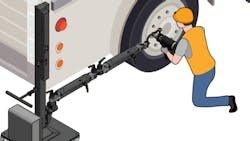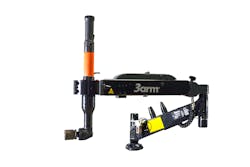Tune up your fleet maintenance with ergonomic arms
Maintenance team safety and strong ergonomic practices is the foundation of reliable fleet services. Unfortunately, transportation and warehousing had the fourth-highest number of nonfatal work injuries and illnesses, according to the U.S. Bureau of Labor Statistics’ most recent information, and The Trucking Injury Reduction Emphasis (TIRES) initiative from the Washington State Department of Labor & Industries found in their 2014 report, Trucking Industry: Examining Injuries for Prevention, that the trucking industry has some of the highest costs and rates of injury out of all industries combined. Of these, some of the most frequent and expensive injuries include:
- Slips, trips and falls
- Strains and sprains (Musculoskeletal disorders, or MSDs)
- Getting struck by or against an object
- Motor vehicle collisions
Of this list, sprains and strains resulting in MSDs are as common as they are debilitating, and especially for maintenance technicians. The repetitive motions and exerting activities performed hour by hour in a fleet maintenance facility are ripe for facilitating this type of injury, so much so that the U.S. Bureau of Labor statistics reported 272,780 MSD worker injuries in 2018, and 28% of injuries in general maintenance and repair workers involved MSDs in the period. The resultant injury claim costs and missed days of work then quickly add up.
Read more: High- and low-tech ways to improve shop ergonomicsIf a shop isn’t making the best efforts to keep their employees safe, they’ll have a harder time finding and retaining labor, all while footing the bill for injuries such as carpal tunnel, which OSHA’s Safety Pays Program estimates can result in over $30,000 in direct costs and around $34,000 in indirect costs.
To avoid these costs in compensation and labor time, the TIRES initiative aims to reduce worker injuries by implementing mechanical aids that improve worker safety and lighten heavy-duty tasks.
Ergonomic arms, such as mobile lift assistance arms and ergonomic tool-holders, fit the bill for these mechanical aids, and they’re a perfect solution for fleet maintenance work.
Ergonomic arms lift the weight and absorb the torque of the nutrunners and impact wrenches technicians would otherwise bear themselves, improving ergonomics and reducing the likelihood of injury. In heavy-duty fleet maintenance work, an ergonomic tool-holder can make removing and replacing tires a much lighter and safer job for technicians, as a robust and mobile lift assist arm should be able to lift heavy tools and absorb up to 885 ft lbs. of torque. Meanwhile, a mobile ergonomic arm can help technicians hold and use heavy tools while working on a vehicle’s undercarriage for a long period of time. Using these tools will make them weightless for the operator and will eliminate the transfer of force and vibration to them, keeping them healthier and more productive.
Read more: Lifts raise bar for ergonomics in the shopOne option for these tools is 3arm America’s ergonomic Lift Assistance Arms. The Series 3, 4, and 6 models are all particularly suited for work in a fleet maintenance shop, with the Series 3 able to hold tools up to 77 lbs. and handle torque up to 479 ft.-lbs. The Series 4 features dual tilting arms that can reach below the mounting point and can withstand mid- to high-weight and torque ratings, with a maximum torque of 221 ft.-lbs. Finally, the Series 7 features a brake locking system and a range of headmembers and can handle a maximum of 885 ft.-lbs.
By focusing on keeping technicians safe and productive, any fleet operation will be able to avoid becoming another statistic while improving their uptime maintenance team safety.
Paul Schoellman is the vice president of sales at IPT America – Improving operator safety and productivity with 3arm America ergonomic lift assist and torque reaction arms. Contact Paul at [email protected].
About the Author

Paul Schoellman
Vice President of Sales
Paul Schoellman is the vice president of sales at IPT America – Improving operator safety and productivity with 3arm America ergonomic lift assist and torque reaction arms. Contact Paul at [email protected].


